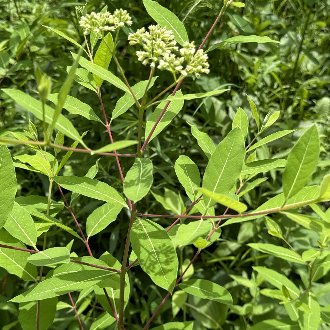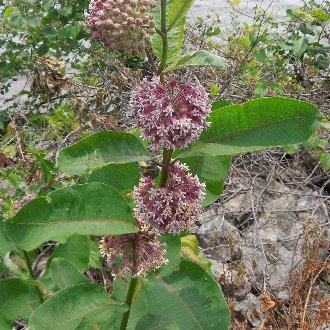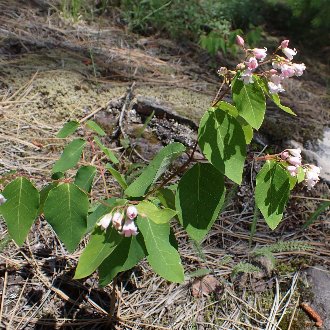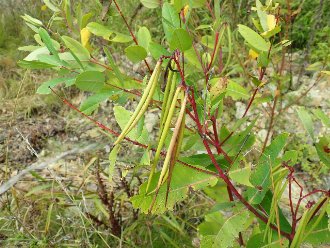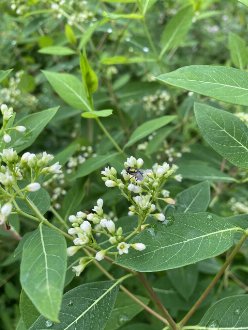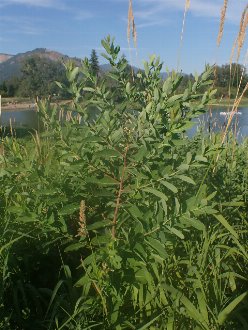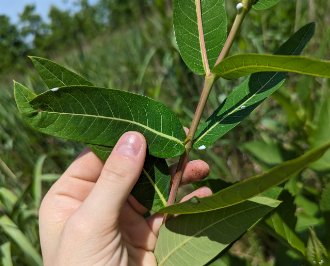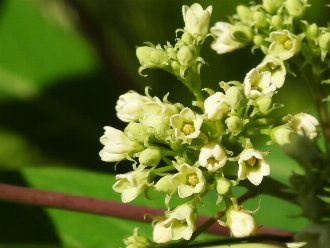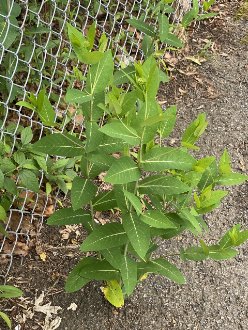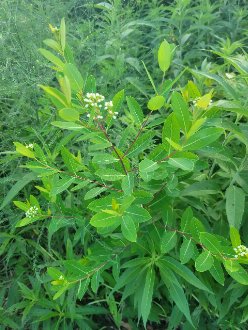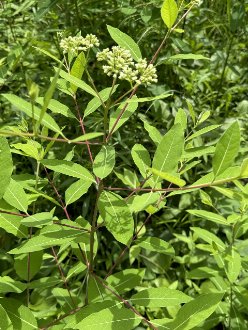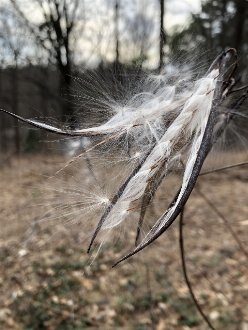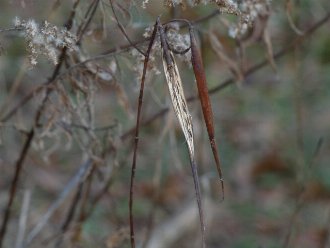Hemp Dogbane (Apocynum cannabinum L.)
Also known as Indianhemp, Indian hemp, common dogbane, amy root, prairie dogbane, rheumatism root, wild cotton.
↑Summary
A rhizomatous perennial of moist, disturbed, sunny areas, native across North America.
↑Range - Expand
| Legend | Color |
| Native | |
| Native or Not Present |
This tentative map is based on our own research. It may have limited data on Canada and/or Mexico, and there is some subjectivity in our assignment of plants as introduced vs. expanded. Read more in this blog post.
Although this plant occurs somewhere in each of these regions, it may only occur in a small part of some or all of them.
↑Similar Plants
↑Habitat
Hemp dogbane is a pioneer species of a variety of sunny, disturbed habitats, particularly but not exclusively on sites that are moist to wet in spring but drier in summer. Natural habitats include wet prairies, wet meadows and other open portions of floodplains, swamp margins, and other open seasonal wetlands. It is often abundant in anthropogenic habitats, including low, wet portions of abandoned fields, pastures, fencerows, ditches along roadsides and railroads, vacant lots and industrial waste ground.
It prefers full sun in most of its range, although in the south of its range it ventures farther into partial shade and more wooded habitats. Although it prefers moist to wet conditions and tolerates temporary flooding in spring, it also tolerates dry conditions, especially later in the growing season, and often persists longer on sites with such conditions as there is less competition from taller plants. It tolerates both acidic and alkaline soils, as well as soils containing sand, gravel, and clay, but on drier upland sites it is more limited to high pH soils.
Humans have increased the habitat for this species, as it thrives in degraded wetlands and is well-adapted to a variety of vegetation-clearing disturbance, including mowing, weedwhacking, herbicide use, and livestock grazing.
↑Life Cycle
Hemp dogbane is a long-rhizomatous perennial that often forms large colonies. New stems often arise as far as several feet from parent plants. Rhizomes are fairly deep under the soil.
Plants flowers in summer and requires cross-pollination to set seed. Flowers are followed by long, narrow pods of wind-dispersed seeds. Most seeds germinate immediately and do not persist long in the environment; some will germinate after a single year but few to none after that. Germination requires warm temperatures; seeds that do not germinate immediately following dispersal usually remain dormant until the next year's warm season and germinate then.
Hemp dogbane has limited tolerance of shade; it competes effectively against most shorter vegetation, but can be shaded out both by taller herbaceous plants, or by trees or shrubs. As such it is usually eliminated in the absence of disturbance.
↑Faunal Associations
Mammalian herbivores usually avoid eating this and other dogbanes (Apocynum sp.) due to their toxicity, but this plant supports a diverse assemblage of insect herbivores specialized on eating this and related plants.
The flowers attract a wide variety of pollinators, including many small bees and flies, as well as skippers and beetles.
The larvae of several moths eat this plant, and mosts are specialists on this and related plants. Marmara apocynella, is a specialist on this species, mining the stem. Other moths eating this plant include dogbane tiger moth (Cycnia tenera), Oregon Cycnia (Cycnia oregonensis), six-spotted gray (Spargaloma sexpunctata), and the snowberry clearwing (Hemaris diffinis). The generalist Zebra caterpillar (Melanchra picta), which frequently eats cultivated crops, has also been recorded eating this plant.
This and other dogbanes are a reliable and only host for the dogbane leaf beetle (Chrysochus auratus): larvae eat the roots, and adults eat the leaves. These beetles concentrate toxins from the plant in order to deter predators, and also have a complex feeding pattern that involves chewing a channel to bleed the toxic sap from the leaves, followed by eating lower-toxin portions of the leaf after the sap has been drained.
The red milkweed beetle (Tetraopes tetrophthalmus), large milkweed bug (Oncopeltus fasciatus), and the dogwood-milkweed aphid (Aphis asclepiadis) eat this and milkweeds (Asclepias sp.), and the plant is also eaten by the dogbane flower midge (Clinodiplosis apocyni).
↑Related Plants
This species is closely related to spreading dogbane (Apocynum androsaemifolium) and the two can hybridize to produce intermediate dogbane (Apocynum ×floribundum), which is sterile but can persist through vegetative reproduction.
↑Links & External Resources
• Apocynum cannabinum (Common Dogbane) | Illinois Wildflowers (About This Site)
• Apocynum cannabinum (Common Dogbane) | USDA PLANTS Database (About This Site)
• Apocynum cannabinum | Go Botany (About This Site)
• Hemp Dogbane | iNaturalist (About This Site)
• Apocynum cannabinum (Indian Hemp) | Missouri Botanical Garden Plant Finder (About This Site)
• Apocynum cannabinum | Biota of North America Project (BONAP) (About This Site)
• Apocynum cannabinum | NatureServe Explorer (About This Site)
• Indianhemp | Fire Effects Information System (FEIS) (About This Site)
• Apocynum cannabinum | Missouri Plants (About This Site)
• Indian Hemp | Maryland Biodiversity Project (About This Site)
• Apocynum cannabinum (Indian Hemp) | Minnesota Wildflowers (About This Site)
• Apocynum cannabinum L. (Indian Hemp, Hemp Dogbane) | Digital Atlas of the Virginia Flora (About This Site)



